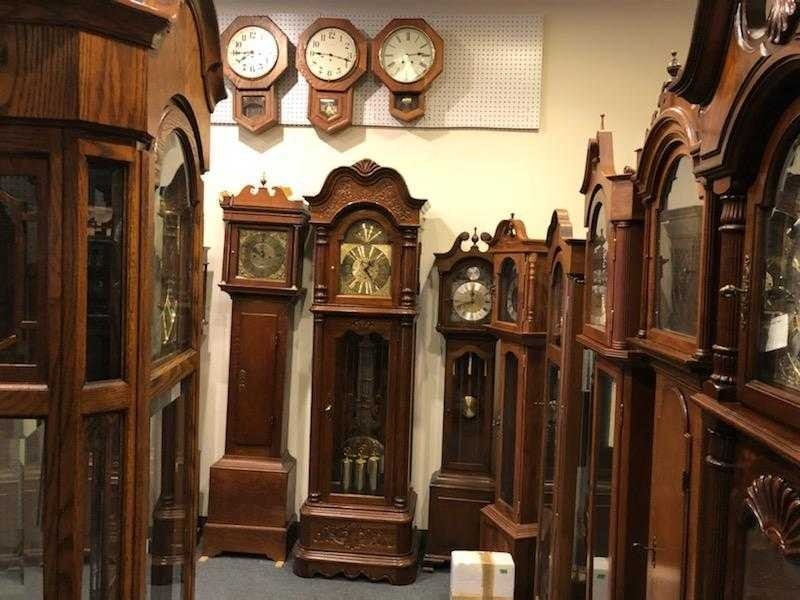‘We kind of feel we’re in groundhog day all the time.’ US Senate passes measure making daylight saving permanent, but what comes next?
Mark Purdy is a timekeeper.
“I’ve been doing this about thirty-some years,” he says. “I got clocks shipped to us from all over the country.”
Inside his Hopkins shop, Blackstone Manor Clock Repair, you can hear the seconds ticking away.
Little wonder that Purdy, surrounded by timepieces, keeps tabs on the twice-a-year switch between standard time and daylight saving time, the ol’ swing forward and fall back.
“Changing spring and fall and going back and getting dark and light just kind of confuses people,” Purdy notes. “From a clock standpoint, that causes some issues, unless you stop the clock or go backward in time.”

Grandfather clocks (KSTP)
Experts say this is more than about resetting clocks — it’s about resetting lives.
Daylight saving time has been a constant in the United States for nearly sixty years, and there have been several efforts to get rid of the twice-a-year time change.
Just weeks ago, the U.S. Senate passed a bill making daylight saving permanent, year-round.
The bill? They called it “the Sunshine Protection Act.”
“You would have more daylight at night, more recreational activities,” explains David Schultz, a political science professor at Hamline University. “Maybe it might help commerce.”
Schultz says daylight saving got a seven-month test run during World War I.
It was made permanent during World War II but was later rescinded, adopted again during the 1974 energy crisis, then tossed out once more a year later.
“The argument for it has been that by having more daylight at night, it would conserve energy, conserve resources,” Schultz said. “What we have learned over time, that largely is not true.”
Supporters say those longer-lit evenings would mean more recreation time and could cut down on crime.
The flip side? Darker mornings.
“My kids are kind of up and at ’em, so I think they would like the light,” says Sarah Rahn, out toy shopping with her 8-year old son Kellan. “I think the sun kind of boosts their mood in the morning, and gets them excited to be outside.”
Rahn says she’s no fan of the fall-back, spring-forward whiplash.
The prospect of a winter sunrise closer to nine o’clock in the morning is not popular in her house.
“We kind of feel that we’re in groundhog day all the time,” Rahn says. “Like every morning when we wake up, it’s dark. We always feel like it’s perpetual winter.”
Sasha Rayl says she’s lucky.
She explains her 15-year old Logan will be starting school later next year.
“I think for his grade next year, they’re going to be starting an hour later, so I’m like, great, that solves a lot of problems,” Rayl says. “I don’t love it being dark in the morning, but I do like more daylight hours and having a little bit of that, so I’m flexible, yeah.”
M Health Fairview neurologist Michael Howell says the country should stop all the time switching.
He says the hour time change causes heart attacks, strokes, and mental health issues.
“So the question is, do you want more light in the evening or more light in the morning?” Howell says. “In general, we need more light in the morning. Our bodies’ circadium rhythms do well when they get bright light in the morning, and our modern life of screens, and phones and tablets gives us too much light in the evening.”
Simply put, Howell says daylight saving isn’t good for our physical well-being.
“If the sun is literally still up because of daylight saving, this is going to make it more difficult to fall asleep,” he says. “Then we’re asking our brains to wake up when it’s still dark out.”
Schultz says daylight saving time would have a big impact locally.
“So for us in Minnesota, it might be great to have in terms of the summer,” he says. “We all enjoy that extra daylight until nine o’clock, if not later, but the daylight saving time, in the winter, it’s going to mean a really long dark morning.”
Minnesota lawmakers actually approved daylight saving last year, but that only goes into effect after a federal measure is approved.
The House of Representatives has yet to vote on the bill passed in the U.S. Senate, and President Biden would have to sign the measure before it becomes law.
For his part, Purdy says he doesn’t reset all the clocks in his shop during time changes.
He says he has hundreds of them, and a full reset would be too time-consuming.
But, Purdy says that some antique clocks have an interesting issue with rewinding the hands during a time change.
“An antique clock that has two springs to wind, or two weights to wind, then you cannot go backward with the minute hand as a rule because that will break something,” he notes. “You can always spring forward.”
Purdy says he doesn’t lean one way or another, standard or daylight saving time.
He says stopping the switch would make like a lot simpler for everyone.
“I think they would all just get used to staying on one time zone, one time frame,” Purdy says.